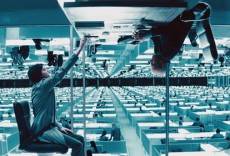November 12, 2013
UK leads the world in talent, but it needs the right culture in which to thrive
 We should never take the UK’s talent base for granted. According to a new report from Deloitte, when it comes to employment levels of people in knowledge based jobs in high skill sectors such as digital media, banking, legal services, software development, telecoms and publishing, London is comfortably the world’s leading city. The study found that London employed 1.5 million people in the 22 sectors surveyed, compared with 1.2 million in New York, 784,000 in Los Angeles, 630,000 in Hong Kong and 425,000 in Boston. The report also predicts that London will enjoy rapid growth in employment levels in these sectors over the next seven years, adding around 100,000 more people and that while a decline in employment is foreseen in financial services, this will be more than offset by strong growth in creative and media businesses.
We should never take the UK’s talent base for granted. According to a new report from Deloitte, when it comes to employment levels of people in knowledge based jobs in high skill sectors such as digital media, banking, legal services, software development, telecoms and publishing, London is comfortably the world’s leading city. The study found that London employed 1.5 million people in the 22 sectors surveyed, compared with 1.2 million in New York, 784,000 in Los Angeles, 630,000 in Hong Kong and 425,000 in Boston. The report also predicts that London will enjoy rapid growth in employment levels in these sectors over the next seven years, adding around 100,000 more people and that while a decline in employment is foreseen in financial services, this will be more than offset by strong growth in creative and media businesses.














 The finest closing sentence of any novel in my opinion is that in The Great Gatsby. “So we beat on, boats against the current, borne back ceaselessly into the past.” It is a reference to the futility of our attempts to escape the past, even as we look to the future, dreaming of how “tomorrow we will run faster, stretch out our arms farther”. F Scott Fitzgerald was referring to people when he wrote it, and Jay Gatsby in particular, but it’s a passage that resonates in a number of ways, especially in those areas of our lives that deal most intimately with what it means to be human. And one of these is self-evidently the workplace, where any articular attempt to define the ideal office for a particular time, including the future, is complicated by the fact that we must always meet the needs of the beasts that inhabit it. Regardless of the tools we have at our disposal with which to work more effectively, or just plain ‘more’ we remain fundamentally the same animals we were thousands of years ago.
The finest closing sentence of any novel in my opinion is that in The Great Gatsby. “So we beat on, boats against the current, borne back ceaselessly into the past.” It is a reference to the futility of our attempts to escape the past, even as we look to the future, dreaming of how “tomorrow we will run faster, stretch out our arms farther”. F Scott Fitzgerald was referring to people when he wrote it, and Jay Gatsby in particular, but it’s a passage that resonates in a number of ways, especially in those areas of our lives that deal most intimately with what it means to be human. And one of these is self-evidently the workplace, where any articular attempt to define the ideal office for a particular time, including the future, is complicated by the fact that we must always meet the needs of the beasts that inhabit it. Regardless of the tools we have at our disposal with which to work more effectively, or just plain ‘more’ we remain fundamentally the same animals we were thousands of years ago.









November 13, 2013
Workplace Week highlights the changing shape of the office
by Richard Byatt • Comment, Events, Facilities management, Workplace design
‘High Street’ at Network Rail’s Milton Keynes base
This year’s Workplace Week which took place last week was a great success, with more people participating and more money raised for charity. Across the week, over 500 people took part, visiting innovative workplaces, attending the Workplace Week Convention or going along to one of the many Fringe events. Workplace Week is organised by Advanced Workplace Associates and supported by CoreNet Global, BCS, RICS, FMA and BIFM. All proceeds go to the Children in Need charity. Around 60 people joined the speakers at the headquarters of PWC on London’s Southbank for the Workplace Week Convention to discuss ‘Driving productivity through the connected organisation.’ The informal atmosphere and roundtable format encouraged participation, with a focus on developments in organisational design, change management and technology.
(more…)